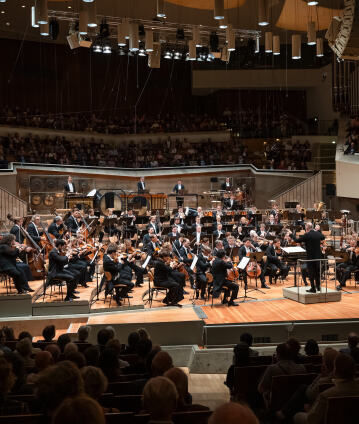François-Xavier Roth conducts “Le Sacre du printemps”

The premiere of Igor Stravinsky’s Le Sacre du printemps triggered the greatest theatrical scandal of the 20th century. The ballet’s narrative of primitive rituals, ecstatic rhythms, and jarring music shocked audiences – and cemented the composer’s reputation. A new work by Ondřej Adámek pays tribute to Pierre Boulez on the 100th anniversary of his birth. Boulez himself is represented by his Rituel in memoriam Bruno Maderna, which achieves a spectacular sound effect with eight instrumental groups arranged throughout the auditorium. François-Xavier Roth conducts.
The composer and conductor Bruno Maderna had close ties to Pierre Boulez, both as a friend and through his engagement with contemporary music. After Maderna died at the age of only 53 in 1973, Boulez dedicated his Rituel to him. As a result of its combination of tonal sensuousness and liturgically strict form, it is one of the composer’s most accessible works. Each of the eight very differently composed groups is assigned a percussion instrument, which provides orientation in the complex superimposition of motifs and layers of sound. According to Boulez, the structure of the composition is inspired by the Christian antiphonal responsorial singing. He also characterised this farewell work for his friend as a “ritual of disappearance and survival”.
The fact that Pierre Boulez’s own musical legacy will “survive” is assured not only by the continued existence of the institutions he founded – including IRCAM (Institute for Research and Coordination in Acoustics/Music) in Paris – but also by the influence of his works on contemporary music. The main motifs of Ondřej Adámek’s orchestral piece Between Five Columns are taken from Boulez’s famous Notations. The five columns referred to in the title symbolise the architecture of the work. As Adámek explains, “The acoustics of these imaginary architectural elements change – sounds reflect, merge and resonate in a variety of forms. Sometimes we hear vastness and freedom, sometimes we feel the confinement and stress of limited space”.
The premiere of Stravinsky’s Sacre caused a scandal not only because of its primal yet modern music, but also because of its shocking subject matter: at the end of a series of rituals, a young woman dances herself to death as a sacrifice to spring. The musical language, which is not strictly atonal but unusually rich in dissonance for the time, and the charged, physical energy of the sounds have lost none of their original impact, even more than 100 years after the work was composed. Later composers such as Pierre Boulez drew on Stravinsky’s polyrhythmic and polytonal techniques.
© 2025 Berlin Phil Media GmbH
Related interviews